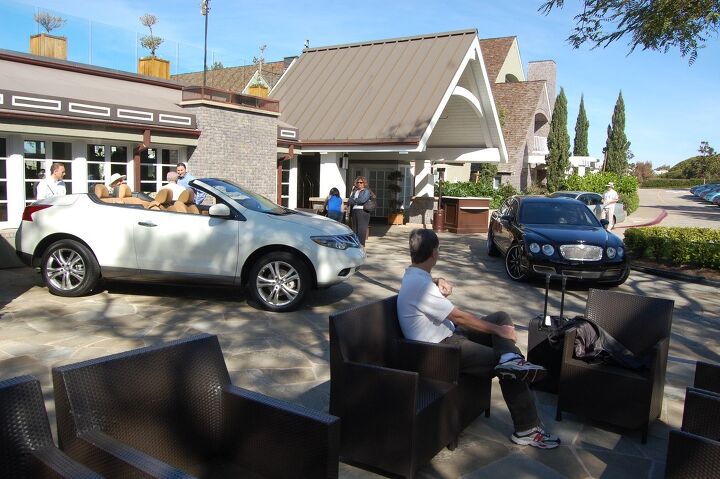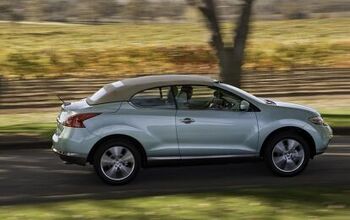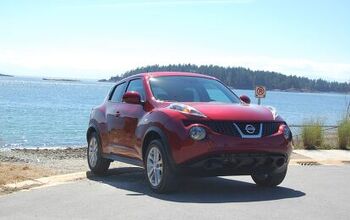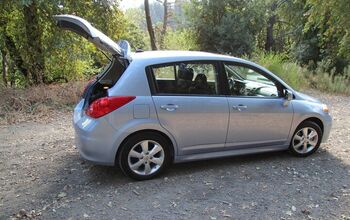Review: 2011 Nissan Murano CrossCabriolet
Given TTAC’s reputation for lack of restraint when it comes to criticism, I was more than a little surprised to see an invite to the Nissan Murano CrossCabriolet launch in San Diego, California. Especially considering that our initial reaction to images of the world’s first soft-top CUV was
If you’ve ever been to a topless beach, you know the basic problem: you expect a bunch of topless Jags and Maseratis, but what you actually get is this, the Nissan Murano CrossCabriolet. Four thousand pounds of roly-poly crossover blessed with the totally misguided belief that people want to see it with its top off. We’ll keep a corner of our eye on this as the LA Auto Show kicks off… but we’ll be sure to avoid eye contact.
On the other hand, strong initial reactions are exactly what this vehicle is all about. And like Nissan’s last controversial design, the Juke, the Murano CrossCabriolet can not be simply judged based on two-dimensional images. Besides, if even Nissan’s designers are willing to acknowledge that the Murano CC is “the answer to a question nobody asked,” surely there must be some kind of logic to this unexpected arrival. So, with an open mind, I dropped in on the strangest, most unique vehicle to launch in ages, hoping to make some kind of sense of something that, on its surface, has no business even existing.
Parked in front of a hideously expensive beachfront hotel in tony Del Mar, the Murano CC makes its first bid at making sense. The sheer awkwardness of the design’s two-dimensional impression fades considerably in the look-at-me automotive arms race that is Southern California. In an environment where AMGs are more common than base-level Benzes (ironically known as “Newport Nissans” for their sheer ubiquity in these parts), the logic of of a 4,416-lb convertible that looks like nothing else on the road becomes just a little more accessible. In fact, from Nissan’s perspective, any $46k vehicle that will get even a little bit of attention from a SoCal valet parking attendant is a downright value proposition. If it takes a tuned Bentley to draw your eyes away from the CC (see above), well, Nissan’s accomplished something.
But the valet parking test is notoriously skewed towards novelty, so just because the CC grabs eyeballs like Lady Godiva now doesn’t mean it’s a successful design. Which leads to a problem: how do you define successful designs for convertible crossovers? Simply put, there is no precedent for what we’re looking at. Yes, it’s impossibly chunky for a two-door drop-top, but it’s also remarkably clean for a topless conversion. The lack of a roll-bar/cross-brace keeps the design blessedly free of typical ” convertible conversion” cues, and the beltline’s upward slope towards the truncated C-pillar keeps the visual mass rearwards, allowing a snug, nearly straight-across folding roof. Though the proportions are out-of-this-world, there’s actually some real elegance to the CC’s clean lines and graceful top: think of it as an overgrown version of a little French C-segment convertible with moon-buggy ride height, and you’re getting the picture. In fact, the least successful aspect of the design is the Murano’s front clip, which is one of the only elements that actually carries over from the fixed-top CUV.
When you realize that only the front clip and instrument panel are carried over from the standard Murano, another apparent hole in the CC’s logic appears: why isn’t this thing an Infiniti? Nissan explains that the goal of this car isn’t simply to sell a huge number of convertibles: it’s actually intended as a halo for the Murano line. Had the Murano CC been, say, an Infiniti FX50 CC, it would have been bringing polarized eyeballs towards a vehicle line that sells in fairly limited quantities. Instead, Nissan hints that the CC will be marketed alongside the standard Murano in hopes of extending the popularity of a line that Nissan already considers a hit.
But because Nissan also wanted to avoid a quick-and-dirty conversion, the CC has been worked-over enough to give it a nearly-Infiniti feel. As with the exterior design, the only thing keeping this from feeling like an Infiniti is the one element carried over from the Murano, the IP (sticklers will find an awkward C-pillar seam in interior photos of these pre-production soft-tops). Otherwise, new front seats have been fitted to give more visibility from the rear seat, and the interior has been worked over considerably.
The only major option for the CC is a $500 leather interior, with swaths the cabin with quilted leather finished in a languidly curvaceous pattern intended to evoke a luxury yacht. Considering the one-trim-level strategy, the $125k+ annual income target audience for the CC, and the fact that this option works so well with the car’s hedonistic vibe, it’s tough to understand why Nissan bothered to make it optional.
But the best thing about the CC’s interior is the spacious rear seat. At around $46k, the Murano CC may be approximately price-competitive with the BMW 3 Series convertible or Audi A5 ‘vert, but neither of its German rivals will fit a 6-foot 3-inch gentleman (like AutoPacific’s Dave Sullivan) in the backseat with good head and leg room. In fact, only the Mercedes E-Class offers comparable comfort for four-up motoring, again making the Murano CC something of a surprise value.
Of course, there are downsides: ingress and egress can be a bit of a squeeze, and that’s only after you manage to swing open the CC’s giant door (which weighs approximately the same as a Versa) and unclip the front shoulder belt from its leather strap (why no seat-integrated front belts on those unique seats seats?). And like any drop-top rear seat, things get a bit windy back there at speed, especially since Nissan preferred to keep the CC’s lines clean rather than adding any wind mitigation screens or baffles. Luckily the rising beltline keeps rear passengers well-cocooned, and the fresh air is not unpleasantly buffeting (although the rear belts will batter against the seats at speed).
And though the rear seats offer Crossover-like comfort for four people, the Murano loses much of its cargo-carrying utility along with its top. Golf clubs for the foursome will fit back there, but overnight gear for four will be a bit of a squeeze. More luggage fits in with the top up, but you must first re-position a bar in the trunk, and then move it back when you want the top back down. Though it sounds inconvenient, this isn’t a huge hassle because you can’t raise or lower the CC’s top on the go anyway.
So, how does it drive? Well, for the surprising amount of sense the Murano CC makes as a value-poseur-mobile, Murano halo or four-up cabrio, on the road the CC falls apart under the weight of its many contradictions. The 265 HP version of Nissan’s ubiquitous V6 works hard to motivate the nearly-4,500-lb CC, calling on some the distinctly un-luxurious areas of the rev-band with frequency. The continuously-variable transmission helps smooth out what might be an otherwise undignified drivetrain (it’s especially intuitive at low speeds), but there’s no sense of effortless pace or power reserves.
Similarly, the unnecessarily tall ride height and soft suspension limit the CC to relaxed cruising, lest passengers become seasick all over the luxury yacht-inspired interior. Luckily the damping is solid enough to keep the huge weight and soft springs from unsettling the ride in sedate driving, but the overall driving impression from both the chassis and drivetrain is of the huge weight of the vehicle. Add to the weight issues the fact that the CC has you looking down on traffic, and piloting the CC becomes a downright bizarre experience; akin to driving a cross between a power boat and a double-decker bus.
In his fictional piece “The CAFE Continuum,” Jack Baruth posited a world in which CAFE had not been passed and where Americans still rolled around in large, comfortable sedans rather than “light truck” crossovers. In that world, the Murano CC would not exist, as large, softly-sprung convertible sedans would be able to seat four adults with the top down. But in this, the real world, large American convertibles simply don’t exist. Instead we get the Murano CC, which cruises competently, grabs stares, and generally comports itself well with the end-of-life, beachfront community lifestyle. But, as a Nissan rep helpfully pointed out, the Murano CC simply brings the crossover through the sedan’s journey from sedan to coupe to convertible. Perhaps, by pushing crossovers into the final stage of evolution, Nissan is actually helping bring the crossover era to an end. It’s certainly tough to see where they go from here.
Nissan provided transportation, lodging and meals, as well as the vehicles, for this day-and-a-half-long test event.
More by Edward Niedermeyer
Latest Car Reviews
Read moreLatest Product Reviews
Read moreRecent Comments
- Michael Gallagher I agree to a certain extent but I go back to the car SUV transition. People began to buy SUVs because they were supposedly safer because of their larger size when pitted against a regular car. As more SUVs crowded the road that safety advantage began to dwindle as it became more likely to hit an equally sized SUV. Now there is no safety advantage at all.
- Probert The new EV9 is even bigger - a true monument of a personal transportation device. Not my thing, but credit where credit is due - impressive. The interior is bigger than my house and much nicer with 2 rows of lounge seats and 3rd for the plebes. 0-60 in 4.5 seconds, around 300miles of range, and an e-mpg of 80 (90 for the 2wd). What a world.
- Ajla "Like showroom" is a lame description but he seems negotiable on the price and at least from what the two pictures show I've dealt with worse. But, I'm not interested in something with the Devil's configuration.
- Tassos Jong-iL I really like the C-Class, it reminds me of some trips to Russia to visit Dear Friend VladdyPoo.
- ToolGuy New Hampshire








































































Comments
Join the conversation
After all the different driving conditions we put the Murano through, it still made 20.6 mpg. That's not bad, considering the EPA range is 18 mpg city and 23 mpg highway.
Nissan must have thought of me when designing this car. I'm 6'4" and have been looking for a reliable, family convertible for about 15 years. I think the Murano CC fills a niche that will prove to be quite popular with families and individuals who want the fun of a convertible with the practicality of a cross-over. Let's put it this way, it certainly outshines the Toyota Versa, I mean Venza. Now, that car is boredom defined. If the front leg and head room are anywhere near the standard Murano, then I'll fit just fine.